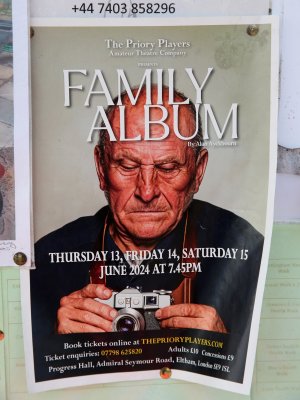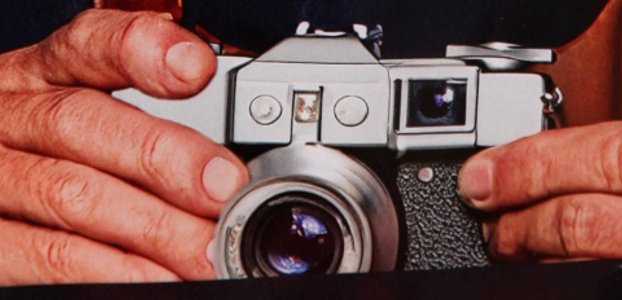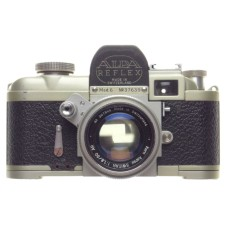You are using an out of date browser. It may not display this or other websites correctly.
You should upgrade or use an alternative browser.
You should upgrade or use an alternative browser.
Mystery camera?
- Thread starter Peter Roberts
- Start date
Ralph Turner
Well-Known Member
Looks like a collapsible Oh-ell!mar lens mounted on a specialist Leitzorknikor rangfinding slr... erm, sorry, no I haven't the foggiest, Peter 
 . A.I generated?
. A.I generated?
Pete Askew
Admin
No idea either. And my 'big book of cameras' in the other country!
Stevenson Gawen
Well-Known Member
Gary R. Smith
Well-Known Member
After a page-by-page review of the still camera in the 1200 page McKeown's, I saw nothing that remotely looks like the front of that pentaprism (?). No text at all on the lens? Why have a pentaprism box and a viewfinder? I'm inclined to believe this may be the new prototype Fujifilm x100vii.
Stevenson Gawen
Well-Known Member
That's dedication!a page-by-page review of the still camera in the 1200 page McKeown's
Gary R. Smith
Well-Known Member
I've emailed The Priory Players and asked if the artist who created the image used a photoshopped or AI camera image.That's dedication!
Stevenson Gawen
Well-Known Member
Well, if they reply that'll settle it once and for all! I'd bet a broken lens on AI being involved somewhere...I've emailed The Priory Players and asked if the artist who created the image used a photoshopped or AI camera image.
Peter Roberts
Well-Known Member
I've got a sneaking suspicion you're on a mission with this, GaryI've emailed The Priory Players and asked if the artist who created the image used a photoshopped or AI camera image.
If I had a copy, I would have looked it up in McKeown's myself, and no doubt have been there for hours getting distracted.
Beth Anthony
Well-Known Member
what's going on with the middle finger on the left hand? is it possible that there was a plate or something covering the pentaprism and those two odd circles?
Ralph Turner
Well-Known Member
what's going on with the middle finger on the left hand? Looks like there's either a custom finger-hold indent, or the camera is slowly absorbing him, digit by digit...
Ralph Turner
Well-Known Member
The index finger on his right hand looks a little suspect, too..
Gary R. Smith
Well-Known Member
Well, it did take quite while to turn all of those pages but I was doing a quick scan for anything that looked like the strange front of the pentaprism housing (if that's what it is)? The fingertips do seem to be sinking into whatever item that guy has grabbed. Maybe it's a cake that's been decorated to look like a camera? I think I saw one of those on the GREAT BRITISH BAKING SHOW.I would have looked it up in McKeown's myself, and no doubt have been there for hours getting distracted.
Gianluca Drago
Well-Known Member
My opinion: it's definitely AI. I've played it enough, so I have no doubts.
Stefan Wilde
Active Member
Stefan Wilde
Active Member
This is not it, but the closest thing. An Alpa 6.
Stefan Wilde
Active Member
Alpa had this funny idea... The first generation covers the period from 1942 to 1952. The models are named Standard, Reflex, or Prisma Reflex, and they were made of sheet metal. The Reflex and Prisma Reflex models had both a reflex viewfinder and a rangefinder viewfinder, with the reflex viewfinder mainly used for framing as it was not very precise. Its mirror had to be manually operated. The reflex viewfinder (chest viewfinder) was protected by a metal cover that also served as a sunshade when opened. The name Alpa-Reflex was engraved on this cover. The presence of three windows on the front easily identifies these models. The rangefinder viewfinder was effective for focal lengths up to 135mm. In the Prisma Reflex models, the reflex viewfinder was replaced by a black rectifying prism, and the viewfinder was at eye level. The models referred to as "Standard" did not have the reflex viewfinder.After a page-by-page review of the still camera in the 1200 page McKeown's, I saw nothing that remotely looks like the front of that pentaprism (?). No text at all on the lens? Why have a pentaprism box and a viewfinder? I'm inclined to believe this may be the new prototype Fujifilm x100vii.
Peter Roberts
Well-Known Member
I'm inclined to agree with you, Gianluca.My opinion: it's definitely AI. I've played it enough, so I have no doubts.
In view of Beth's comment there's something dodgy about the 'photographer' himself. It begs the question: Why? I mean, if they'd wanted a photo of someone puzzling about an old camera I would have been happy to pose with a quizzical look on my face while trying to remember to use my EXA500 lefthandedly
Peter Roberts
Well-Known Member
Wow, Stefan. What a mine of information you are!Alpa had this funny idea... The first generation covers the period from 1942 to 1952. The models are named Standard, Reflex, or Prisma Reflex, and they were made of sheet metal. The Reflex and Prisma Reflex models had both a reflex viewfinder and a rangefinder viewfinder, with the reflex viewfinder mainly used for framing as it was not very precise. Its mirror had to be manually operated. The reflex viewfinder (chest viewfinder) was protected by a metal cover that also served as a sunshade when opened. The name Alpa-Reflex was engraved on this cover. The presence of three windows on the front easily identifies these models. The rangefinder viewfinder was effective for focal lengths up to 135mm. In the Prisma Reflex models, the reflex viewfinder was replaced by a black rectifying prism, and the viewfinder was at eye level. The models referred to as "Standard" did not have the reflex viewfinder.
Stefan Wilde
Active Member
Thank you, but I´m afraid all I have contributed was remembering I´d seen this weird Alpa... the rest is contributed by the internet, more specifically https://www.collection-appareils.fr/x/html/camera-10358-Alpa.htmlWow, Stefan. What a mine of information you are!



